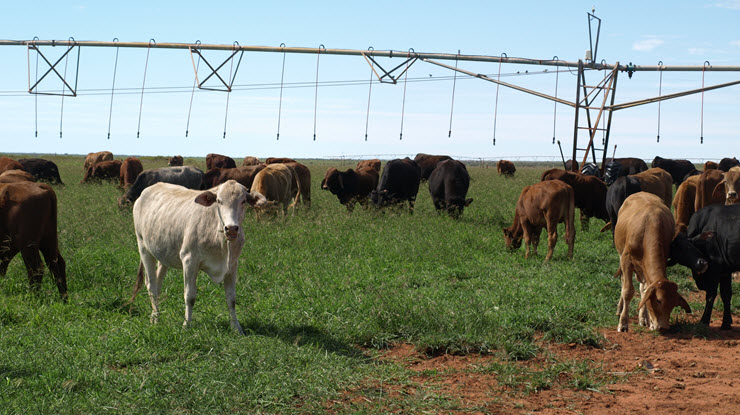
The Rhode less travelled
Irrigated Rhodes grass is helping underpin the evolution of Pardoo Station in WA’s Pilbara into an export Wagyu enterprise.
Pardoo’s Technical Innovation Manager Kevin Bell said there are now 16 centre pivots, each watering 40–50ha, which are further divided into four cells. Between 400 and 1,000 head of cattle are under each pivot, rotating through the cells.
“You have to be on the ball with grazing management,” Kevin said.
“If you’re two days late in moving the cattle on to the next cell, you’ve lost your advantage. It doesn’t just affect the cell that they’re on, but flows on to the other cells as well.
“Over summer, we’re growing 130–150kg dry matter (DM)/ha/day, so in a week there’s an extra tonne per hectare of DM. That’s a lot of feed, and getting the grazing management right can be difficult. You have to manage to minimise the stem and maximise the leaf.
“One thing we’ve learned is that if you can see the grass is going to get ahead of the cattle, you have to bring in the hay mower. You skip a cell with the cattle, leave it for a week and cut it for hay. The mower is a useful tool to reset the paddock.”
Just add water
Cattle grazing on the irrigated Rhodes grass are growing at rates up to 0.7kg/day with no supplements (other than an annual long‑acting selenium injection). The Rhodes grass offers 16–18% protein so the cattle don’t need anything else to meet their protein requirements.
“We add trace elements to the pasture, and they’re top‑dressed with phosphorus and potassium about every three months,” Kevin said.
“We don’t need to add sulphur because that comes through the water, which is high in minerals generally.”
While adding a legume to the pasture mix has been considered, there’s a risk they’re rapidly outcompeted by the grass.
“We’re currently adding about 1,000kg nitrogen/ha/year,” Kevin said.
“We may get additional response (in growth) if we add more nitrogen, but we don’t actually want too much more grass.
“In this environment, only about 40–50% of the grass we grow actually goes into an animal’s mouth. That’s about the best grazing‑usage percentage we can get. We have to accept the loss. Cutting hay gives us better usage (around 80%) but the feed quality is lower. We have to be careful not to spend money on things we can’t sell, and what we sell is kilograms of beef, not grass.”
Worm egg counts are done on the young stock every month and parasite levels are remarkably low.
“The stock are healthy and robust,” Kevin said.
Look out for locusts
The only major problem for the project so far has been a plague of yellow‑winged locusts, which devastated the grass.
“They ate it down to stumps on the ground,” Kevin said.
“There were only about 15 stems per square metre. But the Rhodes just bounced back. Three weeks after the locusts were gone, the grass had recovered.
“The cattle were fine because we had plenty of hay to feed them. But we learned from that and we’ll be a bit more proactive in the future. We’ll get in and control the locusts quicker if we see them again.
“Doing what we’re doing here at Pardoo, we have to learn how to do it as we go along. It’s a good learning exercise and the system is resilient.”



